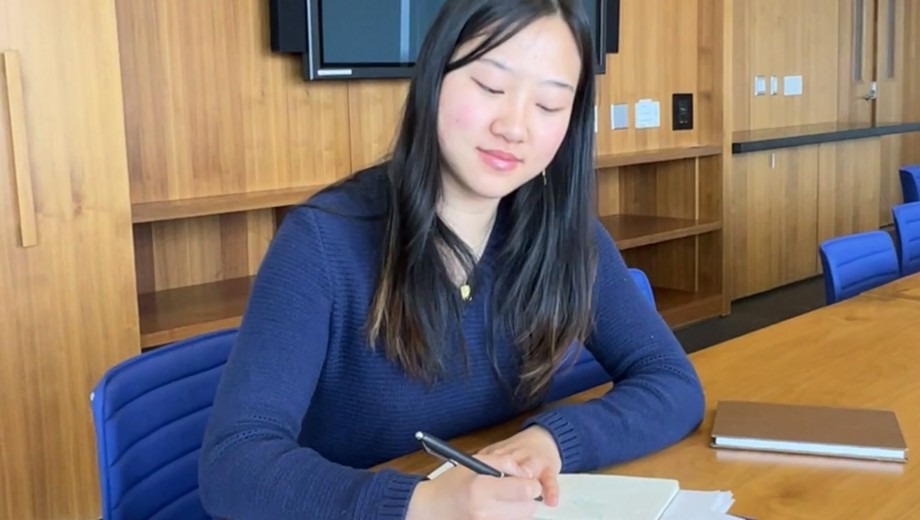Tableau spoke with a UChicago Humanities alumna about her path from double-majoring in Classics and Physics to attending medical school. Combining dissimilar majors is an increasingly popular option for College students—including Donna Tong, LAB’20, Class of 2024, an aspiring poet whose work was published in the Summer/24 issue of the Core magazine.
Tong started out as a Biology major with the goal of attending medical school. She thought about double-majoring in English Language and Literature, but then she took a Creative Writing course, “and I loved it so much,” she says. “I didn’t realize that I would enjoy writing as much as I enjoy close reading and analyzing.”
Tong is now a double major in Biology and Creative Writing. This past summer, her portfolio “Cells to Cells” was awarded the Margaret C. Annan Memorial Prize for poetry; the $1,000 award supports a summer writing project. One of her poems, “Night, Still,” is included under the interview questions below.
How common is it, among undergrads, to have one major in the sciences and one in the humanities?
Very common. I have a friend who is studying Creative Writing and Astrophysics. Another is majoring in Cognitive Science and Music.
I love the humanities. It’s added so much fulfillment to my life. I would have never written a poem past high school, had I not taken a Creative Writing class and gotten the feedback and encouragement. The formal training and mentorship that I received here have helped me learn so much about myself as a writer. My happiest memories of the College are in Humanities classrooms.
Do your majors overlap at all?
There are definitely parallels between scientific research and creative writing. When you’re writing, especially poetry, there’s so much possibility and so much unknown. Every piece of writing is a thought experiment.
There are similar processes as well: coming up with a hypothesis, trying to execute, troubleshooting. Maybe realizing that things aren’t working and coming up with another hypothesis. Then arriving at something to workshop, to see if other people think it worked. In science, the evidence is more concrete. But I feel like there is evidence in poetry, too—whether or not someone is moved, or feels what you want them to feel, or sees what you want them to see.
As a writer, sometimes it’s just hard to begin. I use the scientific language almost as a crutch. Or more like a trampoline. If I’m not sure where the poem will go, I can gather some words, put them on the page, and think about what the words themselves do.
Does your creative work influence the way you do science?
Well, right now a lot of the Biology classes I take are more memorization based. But I do feel that breaking down language to its elements of sound and pattern has given me more insight into how understanding is created. Now when I explain things—whether I’m talking about something scientific or something in my poetry—I think about what kinds of language patterns help someone understand.
I can even see myself using these skills someday in medicine. It’s critical that patients understand what’s going on inside their bodies. Helping patients feel as though they have control, at least over their own knowledge, is really important.
What did your summer project involve?
The goal was to incorporate more scientific language into my poetry and thoroughly investigate that rabbit hole. It began to feed into my thesis. I became more interested in rhythm, which is an important part of training in poetry.
I wrote a few ghazals, a Persian poetic form. I was inspired by the poet Agha Shahid Ali, who wrote a really famous poem called “Even the Rain.” That poem that inspired me to start experimenting with the ghazal form.
The first two lines end in the same word. Then after that, every second line ends in the same word. It’s very rhythmic and feels almost incantatory. Trying to put more technical, multisyllabic language into that form has been interesting—oftentimes difficult. Even I am confused by what it means or what is happening, and what the effect is.
--
Night, Still
By Donna Tong, LAB’20, Class of 2024
The day leaves a slick residue. It is an indigo canvas for the moon’s core still.
The moonbeat resonates, insulated in periwinkle air. Beats go back, forth, still
watched by bobbing seagulls. It’s been years and it’s barely
developed, differentiated, so the shapes become sharper still.
Between coquette charms and chokers you said you saw
it, and the middle looks a lot like the end, and dark still,
the purple starlight focuses into your totipotent pupil. White
feathers laminate the aqua dew twinkle. The night is lazier still
hanging onto the rough blade of a leaf
that will be in the mandibles of a tiny bug, potent and still.
Nothing shuffles across the highway when the sky is
luxuriously denim. Nothing, like the shuffling of playing cards against velour still
-ness. Never like the shuffling of electric light beats against each other, of leaves
on our still
stripped asphalt. (It’s been months). Beneath the watery white slit slips
rhinestone raindrops plinking into the matte or still,
black ocean. Fluorescent mouths tasting something floral.
Guppy eyes blinking bug eyed at soap rainbows arcing across—But still,
our beats sharpen the sun’s white mandibles. Sinking in sky gloss, I feared the hypodermis
of the day, but the plastic nights, the lacquered nights, were never still.

